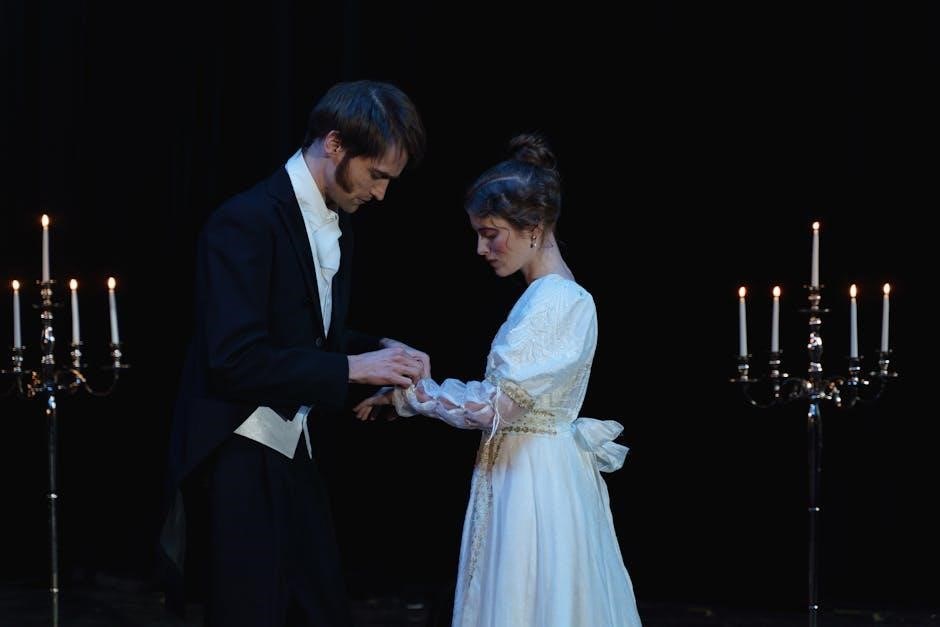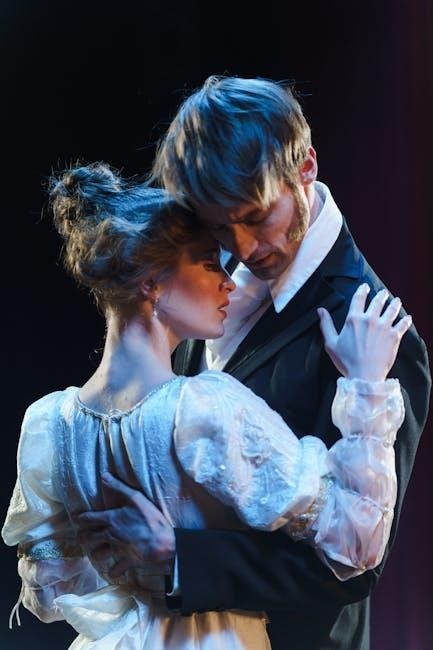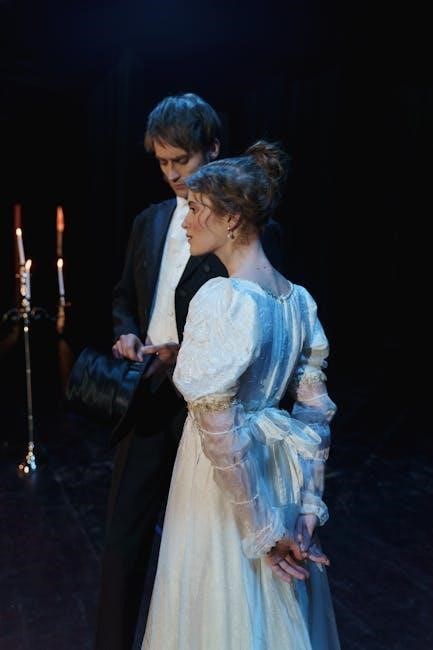the crucible pdf act 3

The Crucible Act 3 begins with Reverend Parris praying beside his daughter’s bed‚ setting the scene for a dramatic and intense court scene‚ full of accusations and tension‚ in Salem‚ Massachusetts‚ 1692‚ online.
Setting and Time Period
The setting of Act 3 in the Crucible is Salem‚ Massachusetts‚ in the spring of 1692‚ a time of great fear and superstition. The story takes place in a rural community where the inhabitants are deeply rooted in their Puritan beliefs. The time period is significant‚ as it was a time of great upheaval and change in the American colonies. The setting is also important‚ as it provides a sense of isolation and claustrophobia‚ which adds to the tension and drama of the story. The internet provides various sources that describe the setting and time period of the Crucible‚ including online study guides and summaries. These sources provide a detailed description of the setting and time period‚ and how it relates to the plot and characters of the story. The Crucible is a play that explores the themes of fear‚ superstition‚ and hysteria‚ and the setting and time period are essential to understanding these themes. The play is set in a specific historical context‚ and the setting and time period are crucial to understanding the characters and their motivations. The internet provides a wealth of information on the setting and time period of the Crucible‚ and can be a useful resource for students and scholars. The setting and time period of the Crucible are rich in historical detail‚ and provide a fascinating glimpse into life in 17th century America. The play is a classic of American literature‚ and continues to be widely studied and performed today. The setting and time period are essential to understanding the play‚ and provide a unique insight into the themes and characters of the story. The internet provides a range of resources and study guides that can help to deepen understanding of the setting and time period of the Crucible.

Plot Summary of Act 3
Act 3 unfolds with intense court scenes‚ accusations‚ and dramatic twists‚ online sources provide detailed summaries and analysis of the plot‚ revealing the chaos in Salem‚ Massachusetts‚ in 1692‚ slowly.
Key Characters and Their Roles
The characters in Act 3 of the Crucible play crucial roles in the development of the plot‚ with Abigail Williams being a key figure‚ her accusations and manipulations driving the story forward.
The character of John Proctor is also significant‚ his struggle with his past mistakes and his desire to save his wife‚ Elizabeth‚ from the clutches of the court‚ adding depth to the narrative.
The role of Reverend Parris is also noteworthy‚ his obsession with his daughter’s condition and his own reputation‚ as well as his involvement in the court proceedings‚ revealing the complexities of his character.
Other characters‚ such as Mary Warren and Giles Corey‚ also contribute to the plot‚ their testimonies and actions influencing the outcome of the trials‚ and highlighting the themes of fear‚ hysteria‚ and the dangers of unchecked power.
The internet provides a wealth of information on these characters‚ including analysis and summaries of their roles‚ and how they interact with each other‚ to create a rich and complex drama.
The characters’ interactions and relationships with each other are expertly woven together‚ creating a tense and dramatic atmosphere‚ that keeps the reader engaged and invested in the story.
The use of dialogue and stage directions adds to the overall effect‚ creating a sense of realism and authenticity‚ that draws the reader into the world of the play.
Overall‚ the characters in Act 3 of the Crucible are well-developed and complex‚ with each one playing a vital role in the progression of the plot‚ and the exploration of the themes and ideas‚ that are central to the play.

Themes and Symbolism in Act 3
Fear and hysteria are dominant themes‚ symbolized by the court’s chaotic atmosphere‚ online resources providing analysis and insights into these themes‚ in the Crucible Act 3‚ very detailed and informative.
Analysis of the Court Scene
The court scene in Act 3 of the Crucible is a pivotal moment in the play‚ as it showcases the hysteria and fear that has gripped the community. The scene is marked by a sense of chaos and disorder‚ as the court struggles to maintain control and establish order. The character of Danforth‚ the deputy governor‚ is particularly significant in this scene‚ as he embodies the rigid and unyielding nature of the court. Through his interactions with the accused witches‚ Danforth reveals a deep-seated paranoia and mistrust‚ which ultimately leads to the downfall of the accused. The scene also highlights the theme of mass hysteria‚ as the crowd becomes increasingly agitated and demanding‚ calling for the execution of the accused. The use of language and imagery in the scene adds to the sense of tension and foreboding‚ creating a sense of inevitability and tragedy. Overall‚ the court scene in Act 3 is a masterful example of dramatic tension and suspense‚ and serves as a powerful commentary on the dangers of unchecked power and hysteria. The scene has been widely analyzed and interpreted by scholars and critics‚ and remains a powerful and thought-provoking moment in the play.

Character Development in Act 3
Characters’ true selves are revealed through dialogue and actions‚ showcasing their motivations and flaws‚ in the online Crucible Act 3 pdf‚ with detailed analysis and summaries available online always.
Abigail Williams’ Role in the Act
Abigail Williams plays a crucial role in Act 3‚ as her accusations and manipulations drive the plot forward‚ showcasing her cunning and ruthless nature. Through her interactions with other characters‚ Abigail’s motivations and desires are revealed‚ demonstrating her complexity as a character. Her relationship with John Proctor is particularly significant‚ as it highlights the tension and conflict between them. Abigail’s role in the act is multifaceted‚ as she navigates the court scene and manipulates those around her to achieve her goals. The online Crucible Act 3 pdf provides a detailed analysis of Abigail’s character‚ including her actions and dialogue‚ allowing readers to gain a deeper understanding of her role in the act. By examining Abigail’s character‚ readers can gain insight into the themes and symbolism present in the play‚ and how they relate to the historical context in which the play is set. The character of Abigail Williams is a significant aspect of the play‚ and her role in Act 3 is essential to the overall plot and themes.

Historical Context of the Crucible Act 3
The Crucible Act 3 is set in 1692 Salem‚ Massachusetts‚ during the witch trials‚ a period of mass hysteria and false accusations‚ as seen in the online pdf version of the play‚ historically.
Comparison with Other Literary Works
The themes and motifs presented in The Crucible Act 3 can be compared to other literary works‚ such as Nathaniel Hawthorne’s The Scarlet Letter‚ which also explores the themes of guilt‚ sin‚ and redemption in a Puritan community. The use of symbolism and imagery in The Crucible is also reminiscent of Edgar Allan Poe’s works‚ which often feature symbols and imagery to convey themes and ideas. Additionally‚ the character of Abigail Williams can be compared to the character of Lady Macbeth in Shakespeare’s Macbeth‚ as both characters are driven by ambition and a desire for power. The online pdf version of The Crucible Act 3 provides a convenient way to access and compare these literary works‚ allowing readers to explore the similarities and differences between them. The comparison of these works can provide a deeper understanding of the themes and motifs presented in The Crucible Act 3‚ and can also highlight the unique aspects of the play. The analysis of these literary works can be done using the online pdf version of The Crucible Act 3.